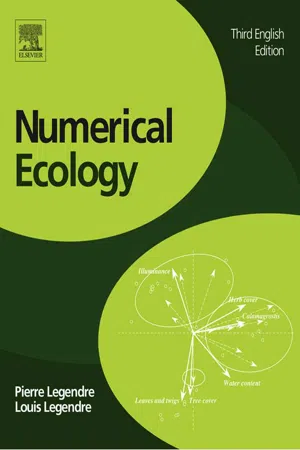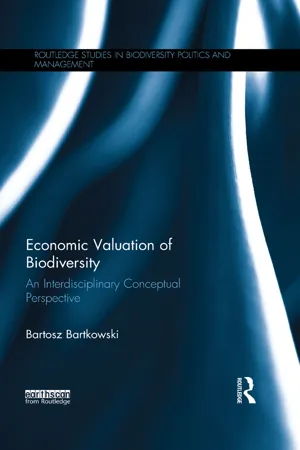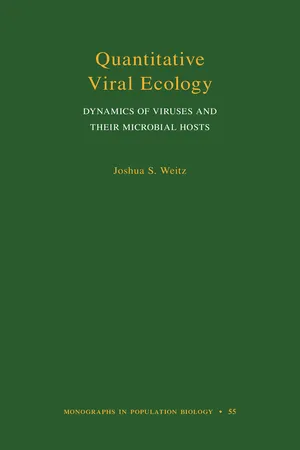Biological Sciences
Simpson's Diversity Index
Simpson's Diversity Index is a measure used to quantify the diversity of a biological community. It takes into account both species richness (the number of different species present) and species evenness (the relative abundance of each species). The index ranges from 0 to 1, with higher values indicating greater diversity.
Written by Perlego with AI-assistance
Related key terms
Related key terms
1 of 4
Related key terms
1 of 3
7 Key excerpts on "Simpson's Diversity Index"
- eBook - ePub
Metagenomics
Perspectives, Methods, and Applications
- Muniyandi Nagarajan(Author)
- 2017(Publication Date)
- Academic Press(Publisher)
(8.2) , there might be a threshold for the independence to occur, and further the threshold may depend on the sampling efforts in the diversity investigation. This kind of subtle difference may be a burden for applied ecologists without gaining commensurable insights from the efforts.Simpson's [8 ] is another commonly used diversity index:D =∑i = 1Rp i 2(8.3)D is inversely correlated with diversity and a better alternative derived from D is PIE (probability of an interspecific encounter):PIE =nn − 11 −=∑i = 1Rp i 2nn − 11 − D(8.4)PIE is the probability that two randomly chosen individuals from a community should represent different species, and it is positively correlated with diversity. In economics, PIE without the adjusting factor n /(n − 1) is the well-known Gini coefficient , i.e., Gini index = 1 − D .The Shannon index is considered to be a better index due to its apparent connection with Shannon's entropy in his information theory. In fact, many probability distributions have an entropy defined; for example, the Weibull distribution, for which the author [1 ] discovered wide applicability in modeling diversity and richness, has the following information entropy:H = γ1 −+ ln1 β1+ 1β λ(8.5)where γ is the Euler-Mascheroni constant, and is equal to 0.5772156649015328606065…. β and λ - eBook - ePub
- Anne E. Magurran(Author)
- 2013(Publication Date)
- Wiley-Blackwell(Publisher)
How should inconsistencies in ranking be dealt with? One option is to compare only those assemblages that are ranked consistently when different orders of diversity are used. The methods described by Rényi (1961), Hill (1973), and Tóthméresz (1995) can be used to accomplish this. Indeed, Southwood and Henderson (2000) argue that such diversity ordering must be undertaken if the intention is to compare communities using a single “nonparametric” measure. In practice, however, most investigators omit this step. This is acceptable as long as it is clear that the aspect of diversity measured relates only to the index used to measure it, and there is no claim or suggestion that diversity in any broader sense is being measured.Figure 5.7 Different measures of diversity do not always rank assemblages in the same way. In this example of soft-sediment macrobenthos from 16 localities in the southern part of the Norwegian continental shelf, there is little concordance between the Shannon index and species richness (rs= 0.25, P > 0.05). The Shannon and Simpson measures, by comparison, produce highly concordant rankings of sites (rs= 0.95, P < 0.01). The exponential form of the Shannon index and reciprocal form of the Simpson index are shown. P values have received Bonferroni correction. (Data from table 1, Ellingsen 2001.)A related problem was noted by Lande et al. (2000), who observed that species accumulation curves may intersect (see also the discussion in Chapter 3). This means that rankings of assemblages can differ as a function of sample size. Lande et al. (2000) recommend the Simpson index for its ability to consistently rank assemblages when sample size varies. Moreover, the probability that the observed (estimated) Simpson diversity accurately reflects the true Simpson diversity increases rapidly with sample size. In their example a sample of 100 individuals was sufficient to correctly rank butterfly assemblages using the Simpson diversity index. The required sample size rose to 2,000 individuals if species richness was used to rank them (see Figure 3.8 ). The Shannon index was rejected due to its high bias in small samples (see also Lande 1996). Platt et al. (1984) have also argued that the diversity of two or more assemblages can only be unambiguously compared when k -dominance plots do not overlap (see Figure 2.6 - Justin Garson, Anya Plutynski, Sahotra Sarkar, Justin Garson, Anya Plutynski, Sahotra Sarkar(Authors)
- 2016(Publication Date)
- Routledge(Publisher)
Diversity concepts and measures: there are multiple distinct concepts and measures of variety, difference, and the diversity of a particular area. The technical surveys of biodiversity measurement found in Gaston (1996), Magurran (2004), and Magurran and McGill (2011) reveal a wide variety of measures and indices, including simple species counts (species richness), relative abundance or evenness metrics, measures of commonness and rarity, indices of compositional differences between areas (β-diversity), and measures of functional, trait, and phylogenetic disparity. I explain these concepts in more detail below.4. Mathematical operationalizations or formalizations of diversity concepts: within these conceptual classes, many mathematical and statistical frameworks have been proposed. For example, genetic diversity is often measured using the so-called F-statistics, which measure expected heterozygosity, but there exist other measures, like Nei’s D, which measures the genetic “distance” or divergence between populations or sub-populations. As mentioned above, Fisher et al. (1943) initiated research constructing statistical indices of ecological diversity. Their index related the number of individuals to the number of species in a community sample, while later indices developed by Simpson (1949) and others were constructed out of the frequency of types (e.g. species) in a community.6In a recent study of quantitative concepts of ecological diversity, which incorporate both the richness and relative abundance or evenness of species in an ecological community, Justus (2010) evaluated eleven distinct indices that take species richness and evenness into account. In their recent review of compositional similarity and β-diversity, Jost et al. (2011) list two incidence-based and eleven abundance-based similarity indices, which measure the similarity of two or more species assemblages. Similarly, Velland et al. (2011) review at least nine distinct indices of phylogenetic diversity.By making decisions at each of these points it is possible to construct many distinct biodiversity concepts and measures. Some decisions may not be necessary for particular contexts; for example, in environmental ethics one might reasonably discuss the value of species diversity while remaining relatively open or pluralistic on taxonomic issues. In scientific contexts, of course, precise definition and operationalization are crucial for formulating testable hypotheses and generating data.- eBook - ePub
- P. Legendre, Louis Legendre(Authors)
- 2012(Publication Date)
- Elsevier(Publisher)
Dickman, 1968 ), fecundity, or any other appropriate measure of energy transfer.Species diversity indices may be used to compare successive observations from the same community (time series: O mode, Fig. 7.1 ) or sampling sites from different areas (Q mode). Coefficients in Chapter 7 compare objects by combining paired information available for each species. In contrast, diversity indices pool the multispecies information into a single value for each sampling unit, before comparing them.Over the years, several formulae have been proposed in the ecological literature for measuring species diversity. The present section only describes the main indices that are found in the modern literature. Species diversity has been the subject of detailed discussions. Early reviews were presented in the milestone books of Pielou (1969 , 1975) and Margalef (1974) and in the review paper of Peet (1974) . A recent account linking species diversity to ecological theory is found in Loreau (2010) .1 Diversity
Hill (1973a) and Pielou (1975) noted that the three diversity indices mostly used by ecologists are specific cases of the generalized entropy formula of Rényi (1961) :(6.31)where a is the order of the entropy measure (a = 0, 1, 2, …), q is the number of species, and pi is the relative frequency or proportion of species i . This formula gives an indeterminate result for a = 1. One can show, however, that the limit of this equation when a tends towards 1 from below (i.e. from 0 to 1) or from above (i.e. from 2 to 1) is the Shannon entropy formula, eqs. 6.1 and 6.34a - eBook - ePub
- Peter A. Henderson, T. R. E. Southwood(Authors)
- 2016(Publication Date)
- Wiley-Blackwell(Publisher)
13.6 a). The Simpson–Yule index is strongly influenced by the few dominant species, although bearing this limitation in mind it could be of value as an indicator of interspecific encounters. As is shown in Fig 13.7 for the Hinkley Point data, all of the non-parametric indices showed the same temporal pattern as species number and gave no additional insight. Thus, species number is often a straightforward measure for comparing diversity between samples collected in similar fashion. If the comparison is to be made between samples which differ in sampling effort, then estimates of total species richness, S MAX, can be compared or rarefaction undertaken to produce a species richness for a standardised effort (see section 13.1.2.1). Figure 13.7 A comparison of a variety of diversity measures applied to monthly fish samples collected at Hinkley Point, England. In this case the data can be considered to be well ordered in that all the indices plotted show the same temporal pattern. Note that the Shannon–Wiener index is the least sensitive to change in the community. Non-parametric diversity indices become useful when used for diversity-ordering (Tóthmérész, 1995). By generating a family of diversity indices it is possible to recognise non-comparable communities. If the objective of a study is to compare communities using a single non-parametric diversity measure, then diversity ordering must be undertaken. 13.1.6 Comparing communities – diversity ordering Different diversity indices may differ in the ranking they give to communities (Hurlbert, 1971; Tóthmérész, 1995). An example from the latter report illustrates the point - eBook - ePub
Economic Valuation of Biodiversity
An Interdisciplinary Conceptual Perspective
- Bartosz Bartkowski(Author)
- 2017(Publication Date)
- Routledge(Publisher)
Chapter 5 with measurable data.Many different measures of biodiversity have been proposed in various contexts: ‘At a global scale, there are roughly 40 potential measures being developed for the Convention on Biological Diversity (CBD) and about 26 indicators being considered in the Streaming Biodiversity Indicators in Europe 2010 process’ (Ding and Nunes, 2014, p. 61; see also Polasky et al., 2005). Most diversity measures focus on different components of it. For instance, genetic diversity can be measured by comparing the genotypic differences between species or individuals. Species diversity is mostly measured by means of rather simple indices, such as species richness (number of species) or different indices originating mostly from information theory, in which species numbers are weighted by relative abundances (i.e. they combine variety and balance information according to Stirling, 2007). A typical example is the Shannon index, which is defined as follows:(3.1) with pi being the relative abundance of species i, i.e. pi = ni /N, where ni is the number of individuals of i and N is the overall population.Phylogenetic diversity can be measured by combining information on species numbers with genetic dissimilarity between them (phylogenetic distance trees/dendograms), thus taking into account Stirling’s variety and disparity categories (Gotelli and Chao, 2013). Functional diversity measures are closely related to phylogenetic diversity, with the difference that the unit of comparison of species are functional traits (such as, e.g., nutrient capture) instead of genetic information (Petchey and Gaston, 2006). Functional diversity is an attempt to more directly capture the influence of biodiversity on ecosystem functioning (on this, see next section). Table 3.1 - eBook - ePub
Monographs in Population Biology
Dynamics of Viruses and Their Microbial Hosts
- Joshua S. Weitz(Author)
- 2016(Publication Date)
- Princeton University Press(Publisher)
Figure 6.5 shows how three different community compositions, each containing the same number of organisms, can each be the most diverse, depending on whether diversity is measured in terms of richness, Shannon diversity, or Simpson diversity. Despite the use of the term “diversity” as a catch-all phrase, the appropriate diversity measure depends, ultimately, on the question. In the study of environmental viruses and microbes, many questions are comparative. For example, is the diversity at one location larger than at another, or does diversity vary with an environmental feature? The new challenge in asking such questions is that samples of viruses and microbes are nearly always a small portion of the community of interest. Therefore, methods are needed to infer the diversity of a community from observations of a sample. As it turns out, inferring the diversity of a large community from a small sample is not as straightforward as it may seem. This is the topic of the next section.6.3.2 ROBUST ESTIMATION OF COMMUNITY DIVERSITY FROM A SAMPLEThe diversity of a sample is readily estimatable given a protocol for distinguishing between types of individuals within the sample. The same cannot be said of inferring the diversity of a community from a small sample. This problem can be understood by thinking about black swans. Most swans—as even the inattentive observer on a nature hike will affirm—are white.3 A sequence of M measurements of the colors of swans in a sampled flock would, with near 100% certainty, be of the form W,W,W,…,W, where W denotes an observation of a white swan. The measured richness, , of the sample is 1, and the measured Simpson and Shannon diversity are . In other words, there is only one type of color and no variation in color within the sample. What then is the expected diversity of the entire population of swans? To estimate this diversity requires extrapolating beyond the current set of observations to the entire set of Ntot swans. Consider the scenario in which a single one of these Ntot swans is black. The true richness of the community is D0 = 2, and the true Simpson diversity is (asymptotically) D2 = 2/Ntot , whereas the true Shannon diversity is asymptotically D1 = log(Ntot )/Ntot . The probability of observing this black swan in a (random) sample of N swans is 1 − (1 − 1/Ntot )N , which can be approximated as N/Ntot so long as N Ntot . As the black swan becomes ever rarer, it is harder to detect in a sample but also has a decreasing consequence on the difference between the measured diversity and the actual diversity—so long as attention is restricted to Simpson or Shannon diversity. In contrast, even as the black swan becomes rarer, the disparity between the measured species richness and actual species richness remains constant. This reflects the fact that richness weights all species equally, irrespective of their relative abundance, including rare species, whereas rare species are the most difficult to observe. Formally, if Sobs is the number of observed species in the sample, then the estimated number of species in the community,
Index pages curate the most relevant extracts from our library of academic textbooks. They’ve been created using an in-house natural language model (NLM), each adding context and meaning to key research topics.
Explore more topic indexes
Explore more topic indexes
1 of 6
Explore more topic indexes
1 of 4






